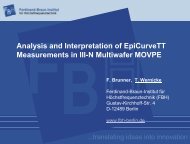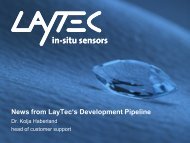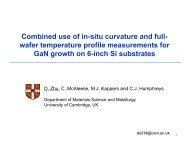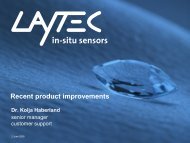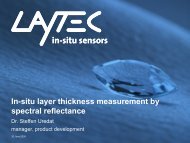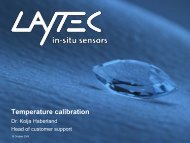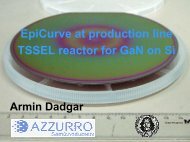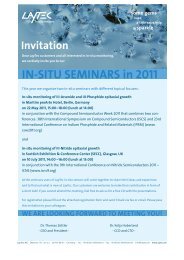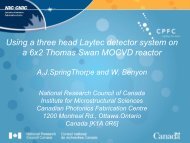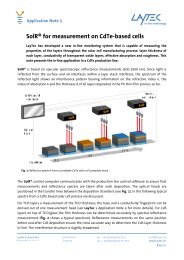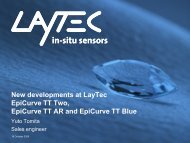Temperature calibration - Laytec
Temperature calibration - Laytec
Temperature calibration - Laytec
Create successful ePaper yourself
Turn your PDF publications into a flip-book with our unique Google optimized e-Paper software.
<strong>Temperature</strong> <strong>calibration</strong><br />
Dr. Kolja Haberland<br />
Head of customer support<br />
23 June 2009
Outline<br />
• motivation<br />
• pyrometry<br />
• pre-<strong>calibration</strong><br />
• viewports<br />
• <strong>calibration</strong><br />
• solutions<br />
23 June 2009 <strong>Temperature</strong> <strong>calibration</strong> 2
Outline<br />
• motivation<br />
• pyrometry<br />
• pre-<strong>calibration</strong><br />
• viewports<br />
• <strong>calibration</strong><br />
• solutions<br />
23 June 2009 <strong>Temperature</strong> <strong>calibration</strong> 3
Motivation<br />
Heteroepitaxy of III-Nitride semiconductors<br />
Wafer temperature has influence on:<br />
• material quality<br />
• composition of ternary compounds<br />
• evolving film stress<br />
substrate/wafer<br />
susceptor<br />
Bow<br />
Dz ~ ΔT<br />
Stress due to lattice mismatch results in wafer bowing which leads to:<br />
� Change in temperature uniformity across the wafer<br />
� Inhomogeneity of material properties<br />
23 June 2009 <strong>Temperature</strong> <strong>calibration</strong><br />
4
Motivation: temperature effects<br />
Vertical temperature profile of a III-N reactor<br />
2...20K<br />
20...50K<br />
>300K<br />
temperature<br />
vertical position in reactor<br />
reactor upper boundary<br />
gas<br />
wafer<br />
satellite susceptor<br />
main susceptor<br />
heater<br />
23 June 2009 <strong>Temperature</strong> <strong>calibration</strong><br />
5
Motivation: temperature effects<br />
<strong>Temperature</strong> access in III-N processes<br />
EpiCurve, Pyro400 (T wafer)<br />
EpiTT, EpiCurveTT (T pocket)<br />
thermo couple,<br />
light pipe<br />
reactor upper boundary<br />
wafer<br />
satellite susceptor<br />
main susceptor<br />
heater<br />
gas<br />
23 June 2009 <strong>Temperature</strong> <strong>calibration</strong><br />
6
Motivation<br />
<strong>Temperature</strong> <strong>calibration</strong><br />
• temperature is most important growth parameter<br />
• themocouple or light pipe temperature used to control<br />
reactor temperature in recipe have high offsets to pocket<br />
and wafer temperature<br />
• temperature measurement might be influenced by<br />
viewport geometry and window transparency<br />
� proper and accurate <strong>calibration</strong> of the EpiTT/EpiCurve<br />
pyrometer is essential<br />
23 June 2009 <strong>Temperature</strong> <strong>calibration</strong><br />
7
Outline<br />
• motivation<br />
• pyrometry<br />
• pre-<strong>calibration</strong><br />
• viewports<br />
• <strong>calibration</strong><br />
• solutions<br />
23 June 2009 <strong>Temperature</strong> <strong>calibration</strong> 8
Pyrometry<br />
Principle of pyrometry<br />
incandescence intensity<br />
infra red visual ultra violet<br />
800°C<br />
700°C<br />
600°C<br />
500°C<br />
0.2 0.4 0.6 0.8 1.0 1.2 1.4<br />
photon energy / eV<br />
950nm<br />
Planck's equation:<br />
L =<br />
�.<br />
2<br />
h 4 c 3<br />
.<br />
(h�) 5<br />
eh��k T B -1<br />
intensity of emission or<br />
incandescence from heated<br />
black body is correlated to<br />
its temperature<br />
But emission of real body (wafer)<br />
is different from black body, so<br />
emissivity � has to be determined<br />
M. Planck, Verh. Dtsch. phys. Ges. Berlin, 2 (1900) 202 and 2 (1900) 237.<br />
23 June 2009 <strong>Temperature</strong> <strong>calibration</strong><br />
9
Pyrometry<br />
Emissivity Corrected Pyrometry<br />
reflectance reflectance reflectance<br />
temperature temperature temperature / / / °C °C °C<br />
thermal emission and reflectance measured simultaneously at 950nm<br />
0.4<br />
0.3<br />
0.2<br />
725<br />
700<br />
675<br />
650<br />
substrate<br />
material A<br />
growth<br />
material B<br />
overgrowth<br />
material A<br />
2500 3000 3500 4000 4500<br />
uncorrected temperature<br />
emissivity corrected temperature<br />
2500 3000 3500 4000 4500<br />
time / s<br />
conservation of energy:<br />
a + r + t = 1<br />
opaque semiconductor:<br />
a + r = 1<br />
Kirchhoffs Law<br />
a (l,T) = � (l,T)<br />
� � = 1 – r<br />
measure r and correct<br />
for changes of �<br />
23 June 2009 <strong>Temperature</strong> <strong>calibration</strong><br />
10<br />
H. Grothe and F.G. Böbel, J. Cryst. Growth 127 (1993) 1010.
Outline<br />
• motivation<br />
• pyrometry<br />
• pre-<strong>calibration</strong><br />
• viewports<br />
• <strong>calibration</strong><br />
• solutions<br />
23 June 2009 <strong>Temperature</strong> <strong>calibration</strong> 11
Pre-<strong>calibration</strong><br />
Factory pre-<strong>calibration</strong> at LayTec<br />
Every pyrometer is pre-calibrated<br />
using a certified black body<br />
radiation source:<br />
• original viewport and window<br />
are used<br />
• <strong>calibration</strong> is accurate if<br />
viewports and windows on-site<br />
are identical (mind coated<br />
windows!)<br />
• <strong>calibration</strong> results in an<br />
accurate temperature<br />
measurement on black bodies<br />
• emissivity correction ensures<br />
accurate temperature during<br />
growth on all materials<br />
Important: keep reactor windows clean!<br />
23 June 2009 <strong>Temperature</strong> <strong>calibration</strong><br />
12
Pre-<strong>calibration</strong><br />
Black body <strong>calibration</strong><br />
• various temperature steps between<br />
400°C and 950°C are measured<br />
assuring linearity in the whole<br />
temperature range<br />
<strong>calibration</strong> report<br />
23 June 2009 <strong>Temperature</strong> <strong>calibration</strong><br />
13
Pre-<strong>calibration</strong><br />
Black body <strong>calibration</strong><br />
provides correct absolute<br />
temperature without any<br />
additional on-site <strong>calibration</strong> for<br />
the following MOVCD reactors:<br />
• AIXTRON planetary G3<br />
• AIXTRON planetary G4<br />
• AIXTRON 200 series<br />
example:<br />
measurement in AIX G3 with BB cal<br />
1060°C<br />
23 June 2009 <strong>Temperature</strong> <strong>calibration</strong><br />
14
Pre-<strong>calibration</strong><br />
Black body <strong>calibration</strong><br />
experience of major LED manufacturer:<br />
• "black body <strong>calibration</strong> of several EpiTT and<br />
EpiCurveTT systems minimized reactor-toreactor<br />
variations to less than 5K in AIXTRON<br />
G3/G4 systems"<br />
• residual temperature variations might even be real<br />
• important: keep windows clean<br />
• window cleaning is standard after any hardware<br />
equipment change (susceptor / ceiling)<br />
23 June 2009 <strong>Temperature</strong> <strong>calibration</strong><br />
15
Pre-<strong>calibration</strong><br />
How is the situation for CCS/CRIUS systems?<br />
AIXTRON planetary G3/G4 AIXTRON CCS/CRIUS<br />
viewport is bigger than beam:<br />
- no clipping<br />
narrow tube<br />
in showerhead<br />
viewport is clipping beam:<br />
- intensity depends on specific viewport<br />
23 June 2009 <strong>Temperature</strong> <strong>calibration</strong><br />
16
Outline<br />
• motivation<br />
• pyrometry<br />
• pre-<strong>calibration</strong><br />
• viewports<br />
• <strong>calibration</strong><br />
• solutions<br />
23 June 2009 <strong>Temperature</strong> <strong>calibration</strong> 17
Viewports<br />
CCS/CRIUS viewports<br />
"new" "old"<br />
• there are different<br />
viewport types in the<br />
field<br />
• different aperture<br />
positions and sizes<br />
• providing different<br />
intensities<br />
• during black body<br />
<strong>calibration</strong> type of<br />
viewport might be<br />
unknown<br />
23 June 2009 <strong>Temperature</strong> <strong>calibration</strong><br />
18
Viewports<br />
CCS/CRIUS viewports<br />
"new"<br />
additional effect:<br />
• nominal identical viewports have<br />
different aperture sizes<br />
• manufacturing tolerances of<br />
diameter is 2.2 mm ± 0.1 mm<br />
= 10% variation possible<br />
• this leeds to significant<br />
temperature variations<br />
� individual on-site <strong>calibration</strong><br />
needed!<br />
23 June 2009 <strong>Temperature</strong> <strong>calibration</strong><br />
19
Viewports<br />
CCS/CRIUS viewports<br />
experiment:<br />
• using a black body<br />
calibrated EpiTT<br />
• measuring identical<br />
temperature ramps<br />
through 5 nominal<br />
identical viewports of<br />
"new type"<br />
• comparing to one "old<br />
type" viewport<br />
about 40K variation!<br />
T Py /°C<br />
950<br />
900<br />
850<br />
800<br />
T 950<br />
T bb<br />
viewport comparison<br />
750<br />
750 800 850 900 950<br />
T bb /°C<br />
23 June 2009 <strong>Temperature</strong> <strong>calibration</strong><br />
20
Outline<br />
• motivation<br />
• pyrometry<br />
• pre-<strong>calibration</strong><br />
• viewports<br />
• <strong>calibration</strong><br />
• solutions<br />
23 June 2009 <strong>Temperature</strong> <strong>calibration</strong> 21
Calibration<br />
Current on-site <strong>calibration</strong> in CCS/CRIUS<br />
Al-Si Eutetcic run<br />
• correlating the Al-Si<br />
eutectic formation at<br />
577°C with the<br />
emission of Si<br />
• very accurate<br />
<strong>calibration</strong> at 577°C<br />
• disadvantage:<br />
temperature much<br />
lower than growth<br />
temperature<br />
23 June 2009 <strong>Temperature</strong> <strong>calibration</strong><br />
22
Calibration<br />
<strong>Temperature</strong> ramp of the eutectic run<br />
slow ramp required to stay close to thermodynamic equilibrium<br />
23 June 2009 <strong>Temperature</strong> <strong>calibration</strong><br />
23
Calibration<br />
Spatial dependant reflectance during<br />
eutectic formation on fully coated wafer<br />
reflectance signal<br />
DC / V<br />
8<br />
7<br />
6<br />
5<br />
4<br />
3<br />
2<br />
1<br />
0<br />
center<br />
edge<br />
-200 0 200 400 600 800 1000 1200 1400 1600<br />
0<br />
0 100 200 300 400<br />
time / s<br />
time position Position auf on Wafer wafer<br />
• eutectic forms in the wafer center first<br />
• at the wafer edge the formation is much delayed due to internal<br />
cooling effects<br />
23 June 2009 <strong>Temperature</strong> <strong>calibration</strong><br />
24<br />
reflectance signal<br />
Reflexion / V<br />
6<br />
5<br />
4<br />
3<br />
2<br />
1
Calibration<br />
Eutectic <strong>calibration</strong> on-site<br />
• optimized design<br />
• still necessary for all<br />
CCS reactors<br />
• optional for AIXTRON<br />
reactors<br />
Important: use LayTec certified eutectic wafers only!<br />
23 June 2009 <strong>Temperature</strong> <strong>calibration</strong><br />
25
Calibration<br />
Eutectic wafer<br />
"spot coated"<br />
type for<br />
viewports<br />
centered over<br />
wafer<br />
"ring coated"<br />
type for<br />
off-center<br />
viewports<br />
23 June 2009 <strong>Temperature</strong> <strong>calibration</strong><br />
26
Calibration<br />
Time-dependant reflectance @633 nm<br />
Reflectance @ 633nm (%)<br />
100<br />
80<br />
60<br />
40<br />
20<br />
0<br />
2000 3000 4000 5000 6000<br />
Time (s)<br />
• Fully-coated samples show smooth and too-early transition<br />
100<br />
• Center-coated and small ring-coated samples exhibit eutectic<br />
80<br />
60<br />
transition at almost the same time (DT ≤ 1 K) 40<br />
Reflectance @ 633nm (%)<br />
20<br />
Inner Ring Al fully #5<br />
Outer Ring Al fully #10<br />
Inner Ring Al small radius #3<br />
Outer Ring Al small radius #4<br />
Outer Ring Al center dot #7<br />
Inner Ring Al big radius #2<br />
• Ring-coated samples are characterized by an abrupt transition<br />
0<br />
3000 4000 5000 6000<br />
23 June 2009 <strong>Temperature</strong> <strong>calibration</strong><br />
27<br />
Time (s)
Calibration<br />
How effective is the eutectic <strong>calibration</strong>?<br />
• analysis of all eutectic <strong>calibration</strong>s in CCS/CRIUS<br />
systems done in 2008 and early 2009<br />
• first, evaluating the measured eutectic formation<br />
temperature according to the black body pre<strong>calibration</strong><br />
• second, evaluating the resulting growth temperature of<br />
GaN (expected to be around 1050°C)<br />
23 June 2009 <strong>Temperature</strong> <strong>calibration</strong><br />
28
Calibration<br />
Raw T at eutectic formation T=577°C<br />
Variabilitätsdiagramm für T_Raw BB@Eutektik<br />
T_Raw BB@Eutektik<br />
630<br />
620<br />
610<br />
600<br />
590<br />
580<br />
570<br />
560<br />
550<br />
540<br />
530<br />
Silizium<br />
Silizium<br />
single<br />
single<br />
EpiCurve 2007-049<br />
EpiCurve 2008-077<br />
Silizium<br />
Saphir<br />
single<br />
inner<br />
EpiCurve 2008-090<br />
EpiCurve<br />
TwinTT 2008-076<br />
Saphir<br />
Saphir<br />
outer<br />
inner<br />
Saphir<br />
EpiCurve<br />
TwinTT 2008-078<br />
outer<br />
inner<br />
Silizium<br />
Silizium<br />
outer<br />
EpiCurve<br />
TwinTT 2008-092<br />
Saphir<br />
Silizium<br />
single<br />
single<br />
EpiTT 2008-185<br />
EpiTT 2008-202<br />
Saphir<br />
Saphir<br />
single<br />
single<br />
EpiTT 2008-213<br />
EpiTT 2008-219<br />
Saphir<br />
Saphir<br />
single<br />
single<br />
EpiTT 2008-222<br />
EpiTT 2008-226<br />
Silizium<br />
Silizium<br />
single<br />
single<br />
Saphir<br />
EpiTT 2008-252<br />
EpiTT 2008-253<br />
EpiTT 2008-255<br />
single<br />
inner<br />
Silizium<br />
Silizium<br />
EpiTwinTT<br />
2008-188<br />
outer<br />
inner<br />
Silizium<br />
Silizium<br />
EpiTwinTT<br />
2008-193<br />
outer<br />
inner<br />
Silizium<br />
Silizium<br />
EpiTwinTT<br />
2008-194<br />
outer<br />
inner<br />
Silizium<br />
Silizium<br />
EpiTwinTT<br />
2008-195<br />
outer<br />
inner<br />
Silizium<br />
Silizium<br />
outer<br />
inner<br />
Silizium<br />
Silizium<br />
outer<br />
inner<br />
Silizium<br />
Silizium<br />
outer<br />
inner<br />
Saphir<br />
Saphir<br />
outer<br />
inner<br />
Silizium<br />
Silizium<br />
outer<br />
inner<br />
Silizium<br />
Silizium<br />
outer<br />
inner<br />
Silizium<br />
Silizium<br />
outer<br />
inner<br />
Silizium<br />
Silizium<br />
outer<br />
inner<br />
Silizium<br />
Silizium<br />
outer<br />
inner<br />
Silizium<br />
Silizium<br />
outer<br />
inner<br />
Saphir<br />
Saphir<br />
Silizium<br />
Silizium<br />
Saphir<br />
Saphir<br />
outer<br />
inner<br />
outer<br />
inner<br />
outer<br />
� we see two types of ports (old and new CRIUS ports) in the field<br />
� one hotter / one cooler than BB pre-<strong>calibration</strong><br />
� considerable temperature variations<br />
EpiTwinTT<br />
2008-200<br />
EpiTwinTT<br />
2008-203<br />
EpiTwinTT<br />
2008-204<br />
EpiTwinTT<br />
2008-205<br />
EpiTwinTT<br />
2008-206<br />
EpiTwinTT<br />
2008-209<br />
EpiTwinTT<br />
2008-210<br />
EpiTwinTT<br />
2008-216<br />
EpiTwinTT<br />
2008-231<br />
EpiTwinTT<br />
2008-238<br />
EpiTwinTT<br />
2008-239<br />
EpiTwinTT<br />
2008-242<br />
EpiTwinTT<br />
2008-245<br />
Mittel=582.7683<br />
Referenzwafer<br />
23 June 2009 <strong>Temperature</strong> <strong>calibration</strong><br />
29<br />
Ring<br />
S/N
Calibration<br />
True T at GaN growth (1050°C) after <strong>calibration</strong><br />
Variabilitätsdiagramm für TT_Wachstum<br />
TT_Wachstum<br />
1200<br />
1150<br />
1100<br />
1050<br />
1000<br />
Silizium<br />
Silizium<br />
single<br />
single<br />
EpiCurve 2007-049<br />
EpiCurve 2008-077<br />
Silizium<br />
Saphir<br />
single<br />
inner<br />
EpiCurve 2008-090<br />
EpiCurve<br />
TwinTT 2008-076<br />
Saphir<br />
Saphir<br />
outer<br />
inner<br />
Saphir<br />
EpiCurve<br />
TwinTT 2008-078<br />
outer<br />
inner<br />
Silizium<br />
Silizium<br />
outer<br />
EpiCurve<br />
TwinTT 2008-092<br />
Saphir<br />
Silizium<br />
single<br />
single<br />
EpiTT 2008-185<br />
EpiTT 2008-202<br />
Saphir<br />
Saphir<br />
single<br />
single<br />
EpiTT 2008-213<br />
EpiTT 2008-219<br />
Saphir<br />
Saphir<br />
single<br />
single<br />
EpiTT 2008-222<br />
EpiTT 2008-226<br />
Silizium<br />
Silizium<br />
single<br />
single<br />
EpiTT 2008-252<br />
EpiTT 2008-253<br />
Saphir<br />
single<br />
inner<br />
EpiTT 2008-255<br />
Silizium<br />
Silizium<br />
EpiTwinTT<br />
2008-188<br />
outer<br />
inner<br />
Silizium<br />
Silizium<br />
EpiTwinTT<br />
2008-193<br />
outer<br />
inner<br />
Silizium<br />
Silizium<br />
EpiTwinTT<br />
2008-194<br />
outer<br />
inner<br />
Silizium<br />
Silizium<br />
EpiTwinTT<br />
2008-195<br />
outer<br />
inner<br />
Silizium<br />
Silizium<br />
EpiTwinTT<br />
2008-200<br />
outer<br />
inner<br />
Mittel=1064.936<br />
� only one level (with noise between 1030 ... 1090°C)<br />
� eutectic cal. has improved situation, but further improvement needed<br />
23 June 2009 <strong>Temperature</strong> <strong>calibration</strong><br />
30<br />
Silizium<br />
Silizium<br />
EpiTwinTT<br />
2008-203<br />
outer<br />
inner<br />
Silizium<br />
Silizium<br />
EpiTwinTT<br />
2008-204<br />
outer<br />
inner<br />
Saphir<br />
Saphir<br />
EpiTwinTT<br />
2008-205<br />
outer<br />
inner<br />
Silizium<br />
Silizium<br />
EpiTwinTT<br />
2008-206<br />
outer<br />
inner<br />
Silizium<br />
Silizium<br />
EpiTwinTT<br />
2008-209<br />
outer<br />
inner<br />
Silizium<br />
Silizium<br />
EpiTwinTT<br />
2008-210<br />
outer<br />
inner<br />
Silizium<br />
Silizium<br />
EpiTwinTT<br />
2008-216<br />
outer<br />
inner<br />
Silizium<br />
Silizium<br />
EpiTwinTT<br />
2008-231<br />
outer<br />
inner<br />
Silizium<br />
Silizium<br />
EpiTwinTT<br />
2008-238<br />
outer<br />
inner<br />
Saphir<br />
Saphir<br />
EpiTwinTT<br />
2008-239<br />
outer<br />
inner<br />
Silizium<br />
Silizium<br />
EpiTwinTT<br />
2008-242<br />
outer<br />
inner<br />
Saphir<br />
Saphir<br />
outer<br />
EpiTwinTT<br />
2008-245<br />
Referenzwafer<br />
Ring<br />
S/N
Outline<br />
• motivation<br />
• pyrometry<br />
• pre-<strong>calibration</strong><br />
• viewports<br />
• <strong>calibration</strong><br />
• solutions<br />
23 June 2009 <strong>Temperature</strong> <strong>calibration</strong> 31
Solutions<br />
LayTec's solutions for T <strong>calibration</strong> issue<br />
• reference light source for in-situ viewport characterization<br />
• allows in-situ transmission measurement of each individual<br />
viewport<br />
• easy and quick solution to avoid ring-to-ring and reactor-to-reactor<br />
variations<br />
• special re-usable <strong>calibration</strong> wafers for T=750°C<br />
• have been developped by LayTec, are in field test<br />
• same wafer can be used in all reactors for <strong>calibration</strong><br />
• high temperature eutectic wafers<br />
• have been evaluated by LayTec<br />
• not enough improvement, as formation is not abrupt enough<br />
23 June 2009 <strong>Temperature</strong> <strong>calibration</strong><br />
32
Solutions<br />
patent pending<br />
Reference light source<br />
800°C hot susceptor surface is<br />
mimicked by this handheld<br />
"cool" reference light source<br />
• 950nm light source<br />
• uniform emitting area of 1 cm²<br />
• equals a temperature of<br />
800°C (black body calibrated)<br />
• put below showerhead<br />
• can measure viewport-toviewport<br />
variations on-site<br />
(ring-to-ring and reactor-toreactor)<br />
• takes just a few minutes<br />
23 June 2009 <strong>Temperature</strong> <strong>calibration</strong><br />
33
Solutions<br />
Novel <strong>calibration</strong> wafers<br />
• specially designed GaN<br />
heterostructure on sapphire<br />
• during heat up reflectance<br />
signal has characteristic<br />
feature<br />
• temperature of this feature is<br />
precisely known (T=750°C)<br />
• <strong>calibration</strong> = heating ramp<br />
• wafer can be re-used<br />
• same wafer can be used to<br />
calibrate all reactors<br />
patent pending<br />
23 June 2009 <strong>Temperature</strong> <strong>calibration</strong><br />
34
Some gems<br />
need a little<br />
extra help to<br />
sparkle<br />
www.laytec.de




